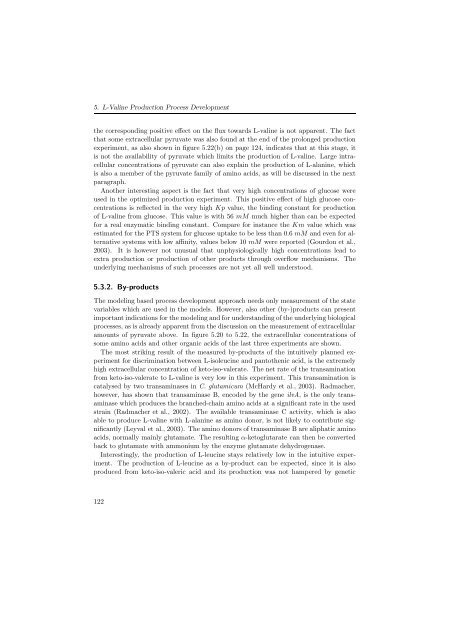Corynebacterium glutamicum - JUWEL - Forschungszentrum Jülich
Corynebacterium glutamicum - JUWEL - Forschungszentrum Jülich
Corynebacterium glutamicum - JUWEL - Forschungszentrum Jülich
You also want an ePaper? Increase the reach of your titles
YUMPU automatically turns print PDFs into web optimized ePapers that Google loves.
5. L-Valine Production Process Development<br />
the corresponding positive effect on the flux towards L-valine is not apparent. The fact<br />
that some extracellular pyruvate was also found at the end of the prolonged production<br />
experiment, as also shown in figure 5.22(b) on page 124, indicates that at this stage, it<br />
is not the availability of pyruvate which limits the production of L-valine. Large intracellular<br />
concentrations of pyruvate can also explain the production of L-alanine, which<br />
is also a member of the pyruvate family of amino acids, as will be discussed in the next<br />
paragraph.<br />
Another interesting aspect is the fact that very high concentrations of glucose were<br />
used in the optimized production experiment. This positive effect of high glucose concentrations<br />
is reflected in the very high Kp value, the binding constant for production<br />
of L-valine from glucose. This value is with 56 mM much higher than can be expected<br />
for a real enzymatic binding constant. Compare for instance the Km value which was<br />
estimated for the PTS system for glucose uptake to be less than 0.6 mM and even for alternative<br />
systems with low affinity, values below 10 mM were reported (Gourdon et al.,<br />
2003). It is however not unusual that unphysiologically high concentrations lead to<br />
extra production or production of other products through overflow mechanisms. The<br />
underlying mechanisms of such processes are not yet all well understood.<br />
5.3.2. By-products<br />
The modeling based process development approach needs only measurement of the state<br />
variables which are used in the models. However, also other (by-)products can present<br />
important indications for the modeling and for understanding of the underlying biological<br />
processes, as is already apparent from the discussion on the measurement of extracellular<br />
amounts of pyruvate above. In figure 5.20 to 5.22, the extracellular concentrations of<br />
some amino acids and other organic acids of the last three experiments are shown.<br />
The most striking result of the measured by-products of the intuitively planned experiment<br />
for discrimination between L-isoleucine and pantothenic acid, is the extremely<br />
high extracellular concentration of keto-iso-valerate. The net rate of the transamination<br />
from keto-iso-valerate to L-valine is very low in this experiment. This transamination is<br />
catalysed by two transaminases in C. <strong>glutamicum</strong> (McHardy et al., 2003). Radmacher,<br />
however, has shown that transaminase B, encoded by the gene ilvA, is the only transaminase<br />
which produces the branched-chain amino acids at a significant rate in the used<br />
strain (Radmacher et al., 2002). The available transaminase C activity, which is also<br />
able to produce L-valine with L-alanine as amino donor, is not likely to contribute significantly<br />
(Leyval et al., 2003). The amino donors of transaminase B are aliphatic amino<br />
acids, normally mainly glutamate. The resulting α-ketoglutarate can then be converted<br />
back to glutamate with ammonium by the enzyme glutamate dehydrogenase.<br />
Interestingly, the production of L-leucine stays relatively low in the intuitive experiment.<br />
The production of L-leucine as a by-product can be expected, since it is also<br />
produced from keto-iso-valeric acid and its production was not hampered by genetic<br />
122

















